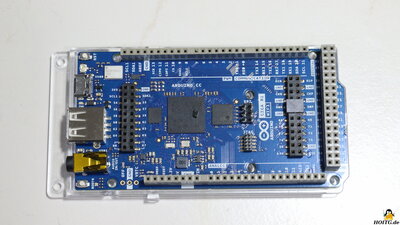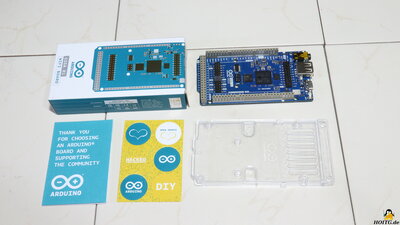| <<< Elegoo UNO R3 Starter Kit | Smartphones >>> |
GIGA R1 WiFi board from Arduino
The gadget in moving pictures with audio
How open is this Gadget?
| Category | Remark | Info |
|---|---|---|
| Firmware |
Firmware is just a Bootloader. Any additional software has to be written. |
? |
| Software |
The Arduino IDE that is needed to upload code is Open Source. |
? |
| Hardware |
Well documented hardware. |
? |
| Elektronik |
Open Source schematics available. |
? |
| Website |
The Arduino website offers gigabytes on tutorials and documentation. |
? |
| Patente |
As far as I know, no patents are claimed. |
? |
The gadget in detail
Figure 1:Totally in the spirit of "How Open Is This Gadget?" the Arduino company also follows the open source philosophy. Over the years, their ecosystem of microcontrollers and accessories has grown steadily and the software has been and is constantly being improved. Microcontrollers are a dime a dozen, but without the appropriate software and documentation, the value of a chip is no higher than the sand from which its basic material, silicon, is extracted. There is plenty of open source hard- and software offered by Arduino, which makes creating projects for "Physical Computing" really fun:
The GIGA board freshly launched by Arduino:
With a total of 76 input/output pins, this has even more GPIOs than the MEGA and DUE. The built-in microcontroller is an STM32 that has two cores that are clocked at 240 or 480MHz, which again means a significant boost in terms of computing power. What is striking is a USB-A interface, via which the GIGA is not programmed, but which can be used to address peripheral devices. The round, 3.5mm audio jack in conjunction with two 12-bit digital to analog and two 16-bit analog to digital converters invites you to experiment with speakers and microphones. Also on board are Bluetooth and WLAN, as well as a camera and display interface.
Technical Data
| Kategory | Value | Remark |
|---|---|---|
| Dimensions |
102x54mm |
Lenght x Width |
| Processor |
STM32H747XIH6 Dual Core |
|
| Clock speeds |
480MHz (Cortex M7) 240MHz (Cortex M4) |
|
| Memeory |
2MB Flash 1MB SRAM |
|
| SDRAM | 8MB | |
| FLASH | 16MB | QSPI |
| Voltages |
USB: 5V Logic Level: 3.3V Input: max. 24V |
|
| GPIO |
75 GPIOs thereof 12 PWM (=analog outputs) 14 analog inputs 2 16-Bit DAC |
Package contents
Figure 2:The package contains only the GIGA Board and a plastic bracket that prevents short circuits from occurring when the board is placed on a conductive surface (metal plate).
Interfaces
Figure 3:With Bluetooth and WLAN, the GIGA R1 WiFi has two wireless interfaces. An external antenna can be connected via the connector on the circuit board. Without this, the range of the two interfaces is very limited.
Up to 76 GPIOs are available. Some of these can be used on the hardware side for specific functions.
Pin 54 - 67 can be used as a camera interface.
The pin header on D1N and D1P can be used as a display port.
The board is programmed and supplied with power via the USB-C interface.
Peripherals such as memory sticks or USB keyboards can be controlled via the USB-A interface.
The 3.5mm audio interface has two 12-bit digital-to-analog converters for outputting sounds. This can also be switched as an input for e.g. microphones.
A CAN bus is available via the pin headers.
My conclusion
The Arduino GIGA is an intermediate step from the classic microcontroller to a fully-fledged PC. The advantage of the GIGA lies in the fact that the architecture and thus the software required for operation remain reasonably manageable.As an advocate of the "less is more" philosophy, the GIGA R1 WiFi is actually total "overkill", because for many really great projects you only need an Arduino UNO. Nevertheless, when it comes to machine control or data processing, more computing power is often simply unavoidable. The GIGA should fulfill pretty much all wishes in this regard.
More questions?
Don't ask me, ask Arduino, because they simply know more about the board: Arduino.cc| <<< Elegoo UNO R3 Starter Kit | Smartphones >>> |


